He was welcomed in by the inhabitants and used Perge as base for his Anatolian campaigns. Alexander was followed by the Seleucids under whom the city prospered and Perge's most celebrated inhabitant, the mathematician Apollonius from Perge lived and worked. Apollonius was a pupil of Archimedes and wrote a series of eight books on geometry. In 188 BC Perge became part of the Roman Empire during which the city flourished. Most of the surviving buildings date from this period.In 46 AD St. Paul started his journey in Perge (biblical Perga) and preached his first sermon here. Perge gradually declined during the Byzantine period, as the Aksu river silted, but remained inhabited until Selçuk times after which it became abandoned.
A visit to Perge starts by entering the archeological site through the Roman Gate, built during the reign of Septimius Severus (193-211 AD). Proceeding through the gate, to the right is the Agora or market place. This structure of 75 x 75 m dates back from the 2nd century AD. The center courtyard and shops were surrounded by a wide stoa, a covered walkway. The floor of the stoa and shops was made of colored mosaics. The agora was not only the centre of Perge's trade, but was also a place for meetings as well as a forum for political, social, and philosophical discussions. The next building is the Hellenistic city gate that dates back to the 3rd century BC. This is certainly the most imposing building of the city and was cleverly designed to protect the city with its twin towers and its horseshoe-shaped courtyard at the back. It is thought that the towers had three floors and were crowned by a conical roof. In the year 121 AD, the horseshoe-shaped courtyard was rededesigned as a courtyard of honor. Behind the courtyard stood a triple arch. Around the arch there are about dozen inscriptions connected with Plancia Magna who lived in the 2nd century AD. She was the daughter of the governor, a priestess of Artemis Pergaia (Diana) and a benefactress to the city. Plancia Magna had the arch decorated with the statues of the emperors and their relatives.
After passing through the Hellenistic Gate and courtyard, one enters a broad, marble-paved double-colonnaded street measuring 300 meters in length that extends from the main gate to the acropolis. The street is 20 m wide and is divided in two by a 2 meter wide water channel running down the middle. At the end of the colonnaded street is the Nymphaeum, a triumphal fountain from where a stream flowed down into the water channel. The nymphaeum or nymphaion is an ornamental semicircular structure and dates from the reign of Emperor Hadrian (130-150 AD). A statue of a river god Kestros was located in the center of this huge fountain. Behind the nymphaeum is the acropolis with some remains of the Byzantine period. To the west of the nymphaeum are the remains of a palaestra dating from 50 AD and dedicated to the Emperor Cladius (41-54 AD).
Returning back to the entrance, there are the excavated Roman baths located southwest to the agora. Out of the site proper, is the horsehsoe-shaped stadium, the largest in Asia Minor, measuring 234 m by 34 m. The stadium had a seating capacity of 12,000 people supported by massive barrel-vaulted constructions. Just beyond the site entrance is also the theatre, which is of the Greco-Roman type and could seat 15,000 people. Unfortunately, it is for some time under reconstruction and unfortunately closed to visitors.
Here are the photos of Perge, click on the thumbnails to see greater pictures

Perge Overview of Archeological Site
Roman Gate of Perge built during the reign of Septimius Severus (193-211 AD)
Roman Gate of Perge
View from the Inside
Piece of dropped ceiling of Roman Gate
Agora with Stoa
Perge's Agora with traces of a round edifice in the middle of the courtyard.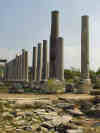
Stoa or Colonnaded Walkway of the Agora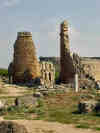
Hellenistic Gate
Hellenistic Gate
Horseshoe-shaped courtyard of honor at the back of the Hellenistic Gate
Bilingual inscription in Lating and Greek of Plancia Magna
Back of Hellenistic Gate and Honorary Courtyard
Colonnaded Street
Colonnaded Street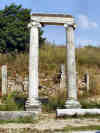
Colonnaded Street
Colonnaded Street divided in two by a water channel
Nymphaeum
Nymphaeum
Nymphaeum with remains of statue of Kestros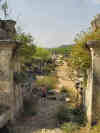
Colonnaded Street
Roman Palaestra
Roman Palaestra
Roman Palaestra
Roman Baths
Roman Baths Frigidarium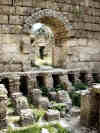
Roman Baths
Roman Baths
Roman Baths
Stadium of Perge
Barrel-vaulted Constructions
Stadium of Perge
234 x 34 m
Stadium of Perge
234 x 34 m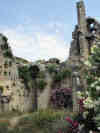
Theatre of Perge